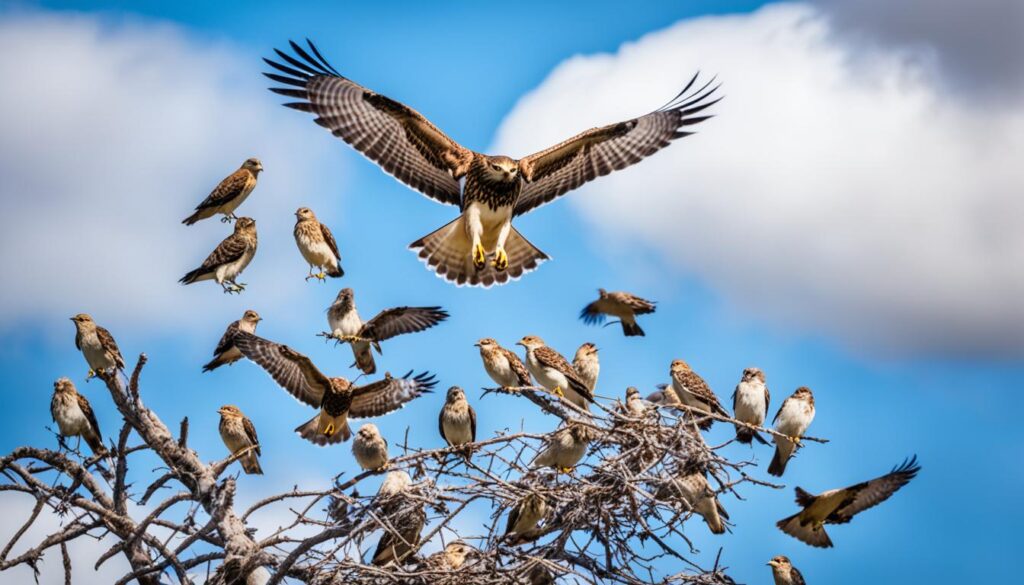As spring arrives, the air buzzes with birds singing. But, you might hear smaller birds chasing larger ones like hawks and owls. This behavior, called “mobbing,” helps protect their homes and young from predators.
Chickadees, titmice, kingbirds, and others often mob larger birds. Hawks, crows, and owls are common targets. This happens more in spring when birds are very protective of their nests and babies.
Key Takeaways
- Smaller birds chase larger birds like hawks and owls to protect themselves.
- This behavior is more common in spring when birds are very protective.
- Seeing a predator near their nests makes birds mob to scare it away.
- Mobbing makes it hard for predators to hunt effectively.
- Small birds are hard to catch for large predators when they know they’re there.
Mobbing: A Courageous Defense Strategy
In the bird world, small birds show amazing bravery with mobbing behavior. They chase and attack bigger birds like hawks, owls, and crows. Their aim is to protect their territory, nests, or young ones.
Explanation of Mobbing Behavior
Mobbing is a strong defense tactic used by many bird species. When they see a predator, they make a call to gather more birds. Together, they attack the intruder, chasing it away with their numbers.
Common Mobbing Species and Targets
- Chickadees, titmice, kingbirds, blackbirds, grackles, jays, and crows are common mobbers.
- They often go after bigger birds like hawks, owls, herons, crows, and ravens.
- This behavior happens all year but is most common when birds are protecting their nests and young.
This brave act shows how clever and strong these birds are. They work together to keep their homes and young safe from big threats. It’s a powerful example of nature’s defense tactics.
Territorial Defense and Nest Protection
Birds mob to protect their territory and young from predators during the breeding season. They become very aggressive in defending their space and their young. This is because of the rise in hormones during this time.
Small birds, like Northern mockingbirds, will even face off against larger predatory birds. These include red-tailed hawks and others. They do this to keep their nest and territory safe. Goshawks are known for their aggressive air-borne diving to chase away intruders.
Other birds use loud sounds, hissing, and posturing to defend their space. They may also use their wings, talons, and bill to scare off threats.
The Migratory Bird Treaty Act of 1918 protects nests with eggs or chicks. It makes it illegal to disturb them without a special permit. Getting a permit for nest removal or bird relocation is difficult. It’s only given for serious health, safety, or property damage risks, not for minor issues.
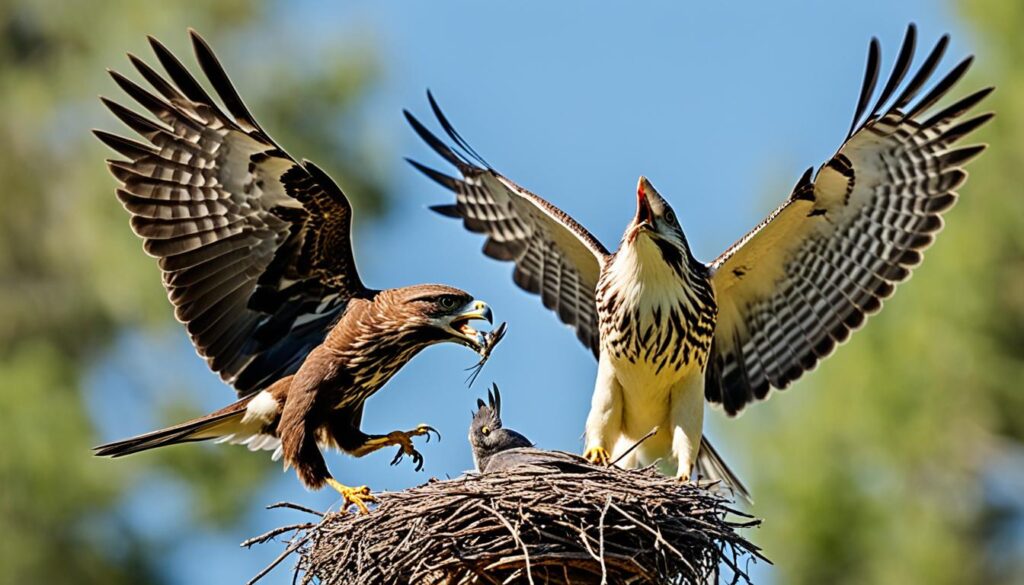
In the Arctic region, raptors like Peregrine Falcons are very aggressive in protecting their nests. They nest far apart, except for the Rough-legged Hawk, which can be close to Peregrine Falcons. This nest association helps the Rough-legged Hawk’s young do better, with more fledglings compared to those not near Peregrine Falcons.
Hormonal Surges and Territorial Aggression
The red-winged blackbird is a prime example of a highly territorial bird during the breeding season. As males prepare to mate and nest, they go through hormonal changes. These changes make them aggressive in defending their territories. They will chase away not only rival blackbirds but also other birds that enter their space.
Red-winged Blackbirds’ Aggressive Territoriality
Male red-winged blackbirds show aggressive behavior due to hormonal surges during the breeding season. Territorial behavior peaks as they compete for the best nesting sites and resources to attract mates. Their hormonal aggression shows through loud calls, wing-flapping, and physical fights with intruders.
“Fighting is primarily done by male birds, and most aggressive behavior in birds happens during spring, when mating and nesting are the primary focus.” – Ornithology Researcher
The red-winged blackbird’s territorial behavior is intense due to high hormonal aggression. This aggressive behavior is key for their reproductive success and the survival of their young during the breeding season.
Cooperative Mobbing: A United Front
Little birds often show amazing teamwork when defending against predators. Cooperative mobbing is when birds of different kinds work together to scare away threats like hawks or owls. This teamwork is not just impressive to watch but also a great way to keep predators away.
Interspecies cooperation is key in this behavior. Birds use similar alarm calls to call others to join the fight. Together, they make a loud noise that scares off the predator. This teamwork helps protect their nests and young from danger.
“Mobbing is often a cooperative effort, with multiple bird species joining forces to harass a common predatory threat.”
The way birds work together in mobbing is amazing. They recognize each other’s alarm calls and join forces against a threat. This shows how adaptable and smart birds are as they work together for safety and survival.
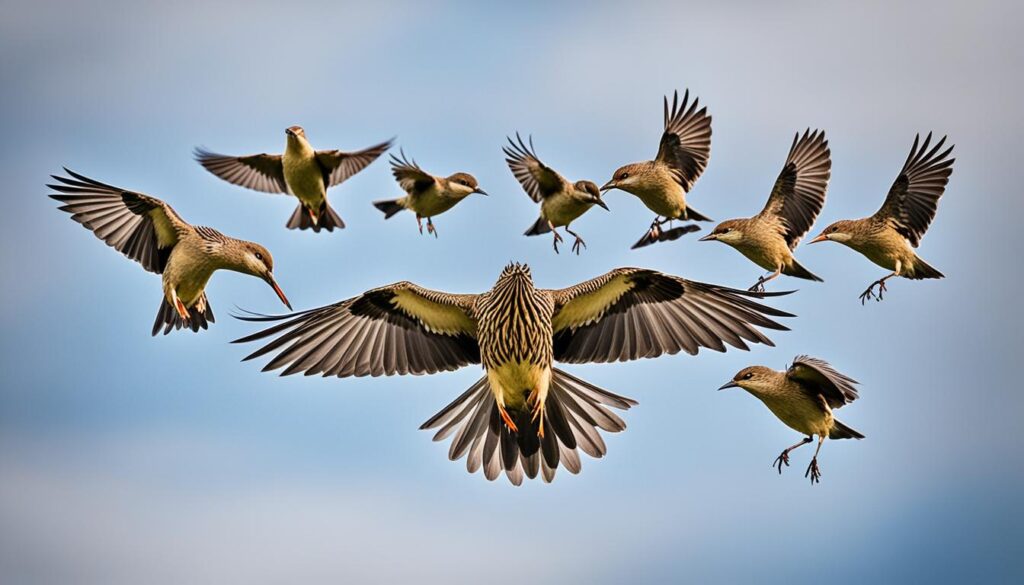
Cooperative mobbing is strong because of the number of birds involved and their different types. By working together, birds can chase away predators better, keeping their nests and babies safe. This behavior shows how smart and adaptable birds are, and how powerful teamwork can be in nature.
Why do little birds chase hawks?
Have you ever seen tiny birds bravely chase a much bigger hawk? This is called mobbing. It’s a way they protect their homes and young from danger.
They do this because they need to keep their territory safe. Even though they’re smaller, their mobbing behavior helps chase away the hawk. It also warns other birds of the danger.
- Mobbing happens a lot in spring and early summer, when birds are very protective of their nests.
- Small birds like northern mockingbirds often chase away hawks and falcons. These birds can eat young or adult birds.
- Because small birds are quick and agile, they can make the big predators leave. This keeps them safe from getting hurt.
Many bird species join together to defend their homes and areas from threats. Chickadees, titmice, kingbirds, and others have been seen mobbing to protect their nests.
“The act of mobbing predators like hawks has been observed in various bird species, indicating a common defensive strategy among different bird populations.”
This behavior shows how birds work together to stay safe. It helps us understand how they survive and protect their young from big dangers.
Mobbing Owls: A Nocturnal Threat
Owls often get mobbed by smaller birds. These birds attack owls during the day to protect their territory. This keeps owls away from nests and young birds resting.
Crows are known for mobbing owls fiercely. Sometimes, over 100 crows chase and harass owls. This group defense is a strong way for smaller birds to keep owls away.
Owls as Frequent Mobbing Targets
Big owls like the Great Horned Owl and the Snowy Owl get mobbed a lot. They are seen as threats by smaller birds. This makes them the main targets of mobbing.
- Smaller owls like the Pygmy Owl are less likely to be mobbed. They are seen as less of a threat.
- Owls and crows often live in the same areas. Owls even use old crow nests, which can lead to more conflicts.
Crows don’t usually kill owls during these attacks. But, their constant bothering can still bother owls a lot. Mobbing helps smaller birds protect their homes and young.
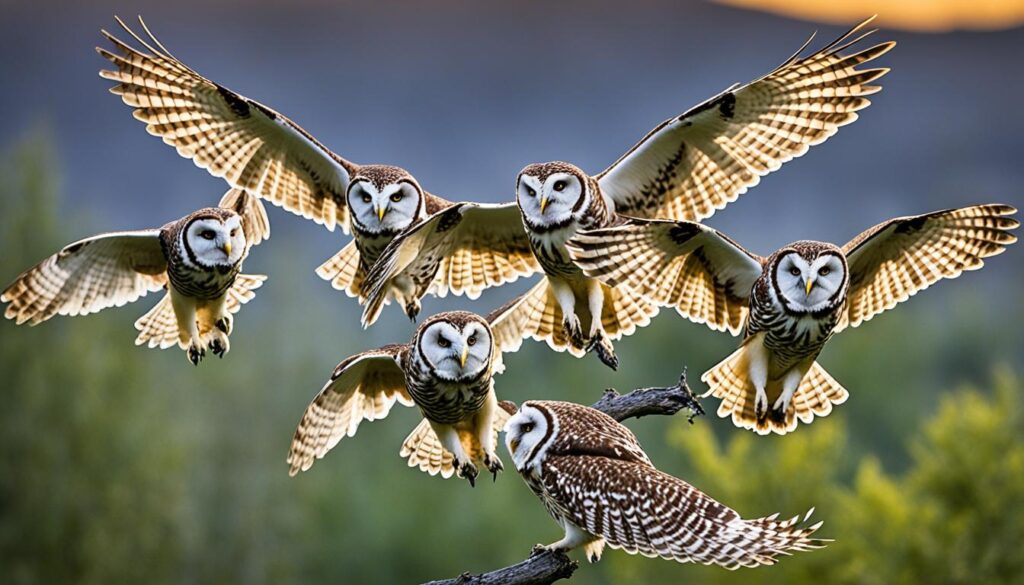
The Predator’s Perspective
Hawks and other large birds of prey usually don’t fight back when smaller birds mob them. This is because they need surprise to catch their prey. A group of smaller birds that are alert and quick makes it hard to catch them.
Also, the risk of injury to the predator from the smaller birds’ attacks is often too high. Predators see that the benefits don’t match the risks when up against a group of birds that defend themselves well.
Why Hawks Don’t Retaliate Against Mobbers
Hawks and other raptors usually avoid fighting with mobbing birds for a few main reasons:
- Loss of the element of surprise: Mobbing birds are very alert and defend themselves well, making it hard for the predator to catch them.
- Risk of injury: The smaller birds can hurt the predator with their pecking and swooping.
- Energy conservation: Chasing or attacking a group of birds takes a lot of energy. The predator might save this energy for better hunting chances.
Understanding the predator’s point of view helps us see the smart decision-making behind the one-sided fights between hawks and smaller birds.
“Predators recognize that the potential rewards do not outweigh the risks when faced with a determined and coordinated mobbing response from their prey.”
Alerting the Neighborhood
When small birds see a hawk or owl, they don’t just fly away quietly. They start making loud mobbing calls. These sounds are like a call to action for all birds. They warn the whole bird world to come together and defend their homes.
The mobbing calls do two things. They call other birds to the fight, making a big group against the predator. The more birds there are, the harder it is for the predator to succeed. They also spread the word to other birds, warning them of danger. This helps the birds protect their nests and young.
This teamwork among birds shows how they work together to keep their territory safe. By joining forces and sounding the alarm, they show the strength of unity against a threat. It’s a powerful way for small birds to protect their homes and future generations.
“The mobbing calls of small birds are not just a raucous display – they’re a vital defense mechanism that protects entire avian communities from predatory threats.”
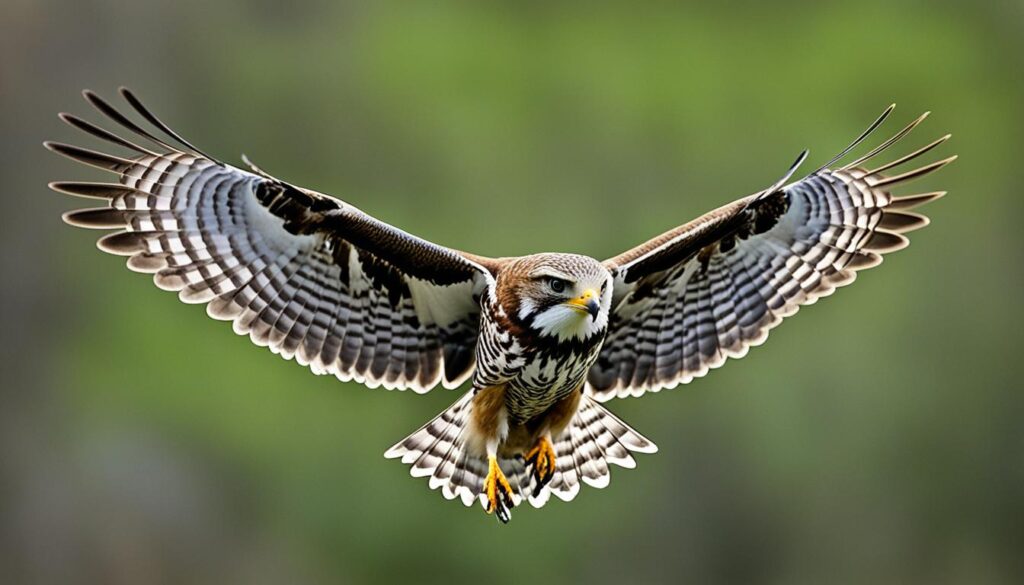
Size Doesn’t Matter: Tactical Advantages
Smaller mobbing birds may seem like easy targets for bigger predators. But they have some big advantages. They can move quickly and change direction fast. This lets them dodge predators who are slower to move.
They also surprise their enemies and work together as a group. This helps them stand up to predators that are much bigger than they are.
Species like chickadees, titmice, kingbirds, blackbirds, grackles, jays, and crows are great at mobbing. They go after hawks, crows, ravens, herons, owls, and eagles. It’s not just brave; it’s a smart way to defend themselves.
These smaller birds are very agile and can sneak up on their enemies. They attack weak spots like the eyes, claws, or feathers. This makes them tough opponents in the sky.
“Smaller birds exhibit greater maneuverability and advantage in aerial combat, making them efficient in mobbing larger species.”
When faced with a mobbing attack, predators often choose to leave the area. They don’t want to risk getting hurt by all those birds. This shows how well the smaller birds work together and use smart tactics.
Mobbing Mechanics: Maneuverability and Surprise
Smaller birds use their quick moves and sneakiness to fight off bigger predators. They can dodge and weave fast, making it hard for larger birds to catch them. The surprise attack and teamwork of the flock also help, as the big bird gets caught off guard and attacked from all sides.
Birds like Cliff Swallows are small and quick, which helps them take down big birds like Red-Shouldered Hawks and Red-Tailed Hawks. Cliff Swallows are great at catching insects and live in big groups. They build nests that look like gourds and work together to protect their homes from predators.
“Swallow bugs, similar to human bedbugs, live in Cliff Swallow nests, coming out at night to bite the birds and suck blood. Research found that swallow bugs had a highly negative effect on the baby birds, leading to weight reduction and high mortality rates among the parasitized nestlings.”
These small birds can distract and confuse the big predators, making it hard for them to hunt. When they work together, they can chase the big bird away, making it safer for them to find food elsewhere.
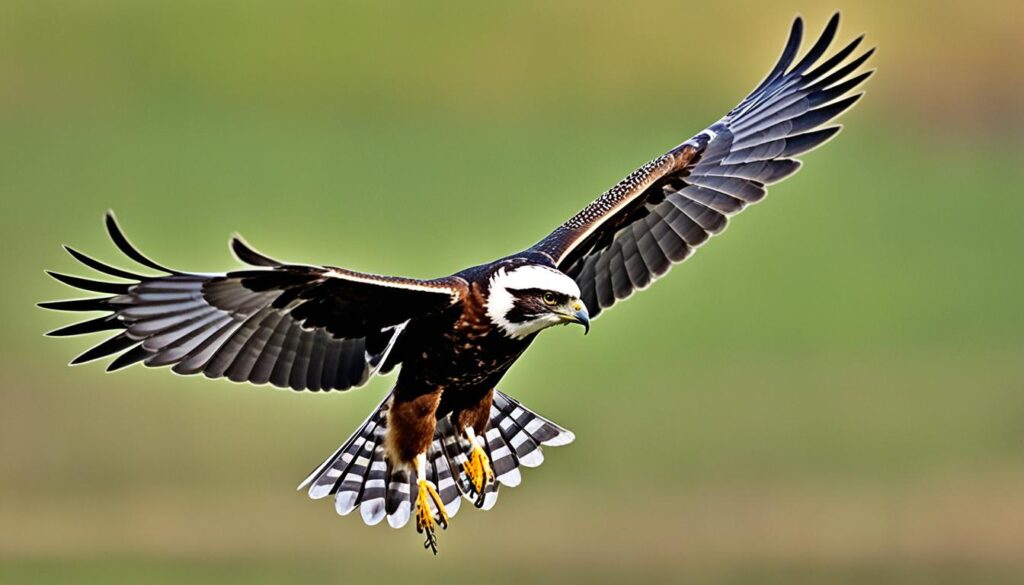
Seasonal Patterns and Nesting Cycles
Small birds mobbing behavior is linked to their seasonal patterns and nesting cycles. This behavior is most seen in spring and early summer, when they are very territorial due to hormonal changes.
As breeding season nears, birds guard their nests, eggs, and young fiercely. They are more likely to face off against larger birds of prey, like hawks, to protect their young. Mobbing becomes less common as the nesting season ends and birds start molting and preparing for migration.
In the breeding season’s peak, birds engage in seasonal mobbing to defend their territories from predators. This behavior is key to their predator defense strategy, helping to protect their nesting cycles and breeding season.
“Mobbing behavior is a remarkable display of avian courage and cooperation, with small birds bravely confronting much larger predators to protect their young and nests.”
As the breeding season ends, the urgency of mobbing decreases. Birds then focus on preparing for their autumn migrations. This pattern of nesting cycles and breeding season defense is vital for many bird species’ yearly lives.
Risks and Rewards of Mobbing
Smaller birds mobbing larger predators like hawks can be a strong defense. But, it’s not without risks. Birds might get hurt from fighting the predator or from the effort of mobbing.
These birds can also get infections if they get cuts during the fight. The close action of mobbing increases the chance of getting hurt and getting infections.
Potential Injuries and Infections
Even with the mobbing risks, the benefits of chasing away a predator are big. Protecting their nests and young is crucial for many birds. The predator defense tactics of mobbing are key to survival.
- American crows often mob red-tailed hawks as a way to protect themselves.
- Birds like gulls, mockingbirds, crows, jays, chickadees, terns, and blackbirds join in mobbing in North America.
- Mobbing helps birds recognize predators and teach others about them.
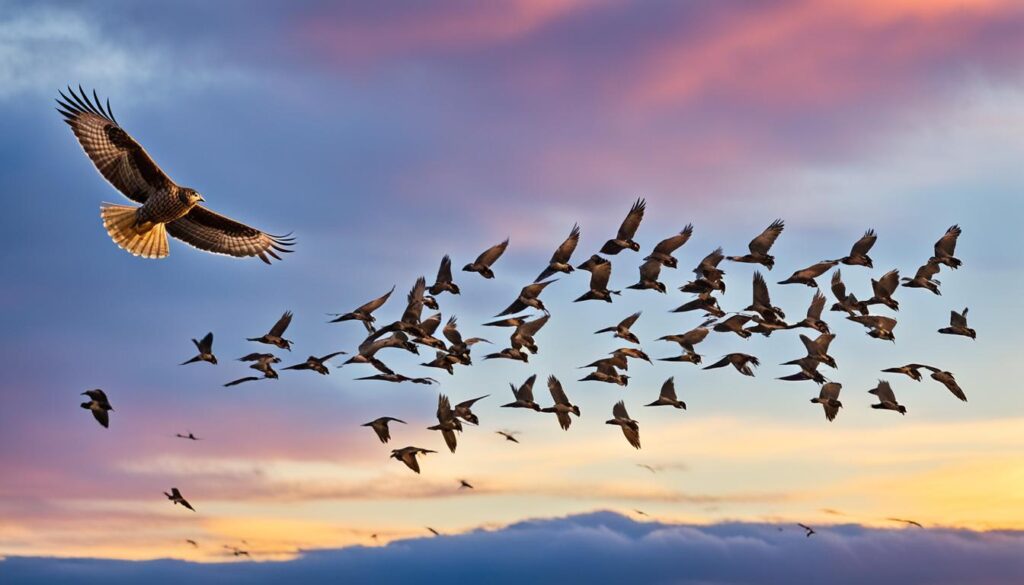
“Mobbing can involve multiple tactics, including noise-making and distraction techniques to protect food sources.”
The risks of mobbing are real, but the benefits are often greater for the birds involved.
The Mobbers Become the Mobbed
In the world of birds, the roles of “mobber” and “mobbed” can switch. This shows how predator-prey relationships change in the bird kingdom. Smaller songbirds often get mobbed, but bigger birds like crows can also mob other birds that enter their space.
During nesting season, birds protect their homes and young fiercely. This leads to more mobbing. Large hawks might get mobbed by crows, jays, and grackles. This shows how different birds interact and defend their territories.
Not all raptors get mobbed the same way. Smaller, quick hawks are less likely to be mobbed. They’re a bigger threat to small birds. But large hawks, not as good at catching small birds, get mobbed more often.
Mobbing doesn’t usually hurt the larger birds. But it can be annoying. Hawks and owls often avoid fights, preferring to leave or just take the mobbing. This way, they keep their dominance without getting hurt.
The battle between mobbers and the mobbed shows the complex world of predator-prey dynamics and interspecies interactions among birds. As birds change and adapt their mobbing roles, they show how they survive and thrive in their own ways.
Conclusion
Little birds bravely chase and mob larger birds like hawks and owls. This shows how they defend their homes and young. Birds like chickadees and jays work together, using their quick moves and surprise to chase away bigger birds.
This behavior is part of their survival strategy. It helps keep the ecosystem balanced. Hawks control smaller animal numbers and protect crops. But, the smaller birds’ teamwork and warning calls show how they adapt to threats.
Learning about why little birds chase hawks teaches us about animal behavior and nature’s balance. By studying these bird interactions, we learn about their strength and importance. They play a key role in defending against predators and shaping our natural world.
FAQ
Why do little birds chase and mob larger birds of prey like hawks?
Smaller birds chase larger birds of prey to protect their homes and young. This behavior is called “mobbing.” It happens a lot in spring when birds are very protective. Birds like chickadees and crows join forces to scare away hawks and owls.
What is the purpose of mobbing behavior in birds?
Mobbing helps birds defend their territory and young from predators. In spring, birds get very protective because of hormonal changes. They risk fighting off bigger birds to keep their homes safe.
What are the most common mobbing species and their targets?
Chickadees, titmice, and crows often mob larger birds like hawks and owls. This happens a lot in spring when birds are very protective. They work together to keep their nests and young safe.
How do smaller birds coordinate and organize their mobbing efforts?
Smaller birds use alarm calls to call others to join in mobbing. This way, they work together to scare away predators. This teamwork makes them more effective at protecting their nests and young.
Why don’t larger predatory birds retaliate against the smaller mobbing birds?
Hawks and other big birds don’t usually fight back against smaller birds. They need surprise to catch their prey. Fighting off a group of smaller birds is hard and not worth it for them.
How do the smaller mobbing birds overcome the size disadvantage against their predatory targets?
Small birds are quick and agile, making it hard for big birds to catch them. They also work together, which surprises and confuses the predators. This helps them stand up to much larger birds.
Are there any risks associated with mobbing behavior for the smaller birds?
Mobbing can be risky for small birds. They might get hurt or catch infections. But, it’s often worth it to protect their homes and young.
Can the roles of “mobber” and “mobbed” be reversed in some situations?
Yes, sometimes the roles change. For example, crows can mob hawks. This shows how complex bird interactions can be.
